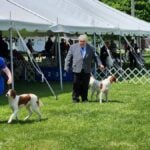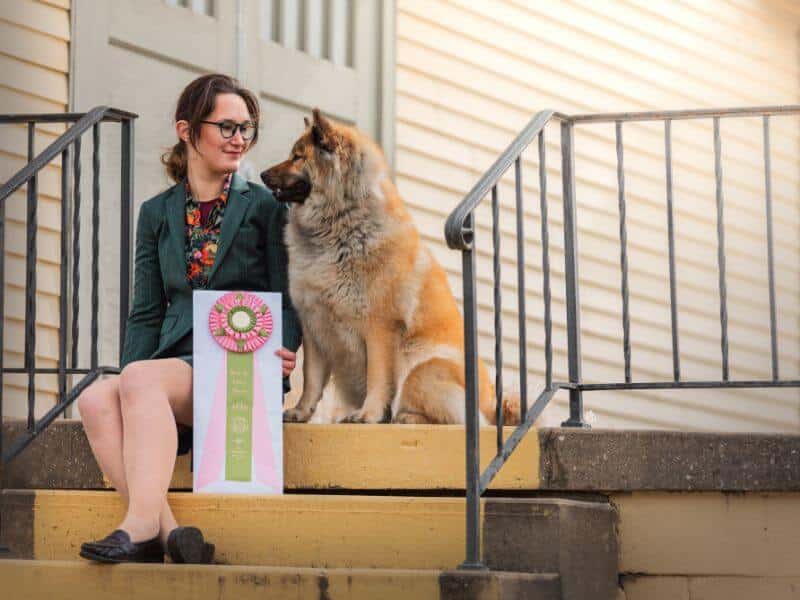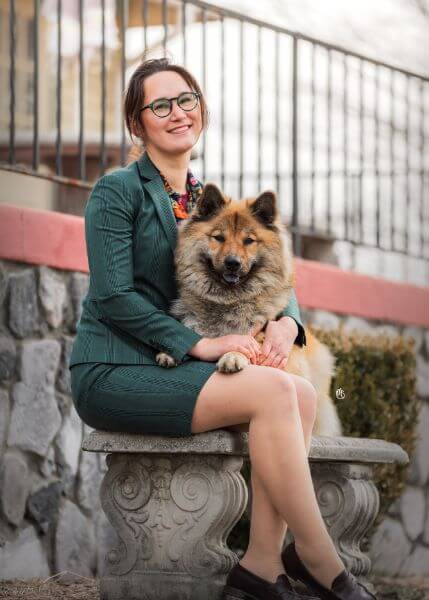
Home » Interview With Owner Handler Kelsey Keefe

Hello! My name is Kelsey Keefe, I live in Massachusetts. I really like Eurasiers… and cats, come to think of it. Presently, I am serving on the Board of Directors as the Communications Coordinator and Clerk for the United States Eurasier Club. To be honest, I like most things, but I am a touch picky about it because I’ve a bit of a “just-so” sort of personality. I have always had Siamese and color-point mix cats because they are pesky, high-energy, affectionate, and highly engaged with their people. In cat circles, they’re dog-like. Eurasiers are cat-like. Somewhere in the Venn diagram of finding those traits appealing in both species, you’ll find me. I have Eurasiers and haven’t been in the breed particularly long, but my four-year-old girl has been a delight to live with and I look forward to her first litter this winter.
“Rhubarb” is a four-year-old Eurasier who entered her first show in June 2021. In the time since, we’ve done five other “weekends out.” We’ve been under 24 total judges and she’s earned seven Best in Open Show placements with ten additional Group placements. She was the second Eurasier to earn their Certificate of Merit (the first US-bred Eurasier to earn their CM!), and in a really flattering sweep she was the first Eurasier to earn her Certificate of Merit 2 (CM2).
Kelsey Keefe: I think a lot of folks who are just getting into dogs grew up watching The National Dog Show on Thanksgiving Day. My first dog was a rescued Norwegian Elkhound and I had little exposure to purebred dogs otherwise. Catching the slightest glimpse of an Elkhound in Groups on TV was a little too exciting for what it was. At the time, though, I had never met another Elkhound and seeing one on TV was really important.
There was something intangible about the sport that I found terribly fun. I discovered the Eurasier in a similar way, although the medium was different. When I began looking into dogs, I’d follow hashtags on Instagram—I was looking at the Keeshond, Finnish Lapphunds, Samoyed… Poodles, of course, and then various other breeds that seemed to suit my goals. Through the Keeshond and Samoyed hashtags, I was suggested Eurasier accounts and the whole situation spiraled from there.
I own a small business with a walk-in storefront for computer and phone repair, and needed a dog that would be “cute” but not overly friendly. Eurasiers really clicked for what I wanted: adaptable, savvy with cats and children, indifferent or aloof with strangers but not wary or nervous, confident without the exuberance of other breeds, affectionate with their family, and moderate energy level and size.
All of these different qualities sounded exactly like the sort of medium-sized dog that would thrive as a pet that could come with me everywhere. They fulfill this sort of niche for me, socially, as someone who is a huge proponent of the role of well-bred pet dogs that were always companions first. Sometimes, that’s just what the doctor ordered. “Rhu” is very much a community canine; she’s known around our town, and I think there is something very sweet about sharing her like that with my community.
Kelsey Keefe: I grew up with various dogs. I had a Norwegian Elkhound for about a decade who came to us second-hand and was a delight and everything I’d want in a dog. We also had a little Shiba Inu mix who was naughty and sweet and silly. They’ve long since passed, and my current girl is four years old. She is very much my first “real dog” as a grown person: my first show dog, my first dog I’ve trained myself, and certainly my first breeding prospect. As above, I was looking for a very niche sort of pet dog that could fulfill a specific role in my life and I found the Eurasier. From there, I went from casual pet home to absolute fanatic, which I think comes with the territory in any breed that is sitting pretty in AKC FSS.
Kelsey Keefe: I’m currently on rotation between three different places with drop-in handling classes. They’re diverse and great places to casually see other breeds and allow your own dog to be seen in a low-pressure environment. And the various locations and people involved are good for the dog in a social sense.

Kelsey Keefe: I’ve watched quite a few videos through Puppy Culture. Their videos got me through puppyhood and their beginner videos on teaching a simple free-stack saved my life. As I truly began in a place of blissful ignorance and have a deep-seated fear of embarrassing myself, diving in to learn about conformation and structure, learning to develop an eye for it, as well as developing an understanding for the health and temperament of the breed as a whole… any educational materials, regardless of breed, have been valuable to me. I think it’s important to look at the judging materials of a diverse group of dogs; to observe what is successful at communicating information to judges and enthusiasts. It helps me to loosely sketch what may be successful as our breed fledges from FSS into the Miscellaneous Class in the years to come, and full recognition beyond.
I’m happy that there are still opportunities like Juniors and Beginner Puppy where we can exhibit our dogs and, for the right dog, particularly in Juniors, really have a lot of fun with it.
Kelsey Keefe: Unfortunately, Foundation Stock Service & Miscellaneous Class breeds cannot compete in NOHS. So, I do not! I think there is space for our dogs there, as one of the important distinctions within Open Shows is that the rules do not allow for professional handlers, but alas.
Kelsey Keefe: Open Shows are pretty limited in our classes; a few groups for young dogs, Open, Bred-By, and we cannot have a paid/professional handler. So, that being what it is, I’m an Open Class girlie, but I look forward to having a puppy to enter in BPUP as we can compete in that venue. In addition, I’m hoping to put my girl in with a Junior Handler when the opportunity presents itself. It is difficult at times to exist in the liminal space where our dogs are only provisionally under AKC’s umbrella. I’m happy that there are still opportunities like Juniors and Beginner Puppy where we can exhibit our dogs and, for the right dog, particularly in Juniors, really have a lot of fun with it.
Kelsey Keefe: I’ve established some really lovely local connections, and I adore the folks at my handling classes: Tracie Liberte, Cotton Silverman, and the exhibitors ringside as well. Collectively, we are all enthusiasts of our breed who are exemplifying what Foundation Stock means. Our dogs are the beginnings of a legacy within AKC, and although our histories are all longer, there is something really humbling about getting to know folks who are importing dogs from abroad and establishing their kennels and breeds within the United States. We share a lot of struggles, too, and the conversations are so valuable, both online and in person, that the community really is what “hooked” me more than the sport itself.
Within Eurasiers, I wish we had more exhibitors. Speaking to folks about conformation within the breed, and particularly Marissa Armstrong (Cersai Eurasiers) who was kind enough to inform me that my awkward puppy was actually growing up to be a nice dog, and further didn’t discourage my futile attempts to begin in AKC, has been so important. I’m hopeful that as our breed continues to grow in popularity that we see new exhibitors come through the ranks and I hope to be a mentor to these folks during their journeys with their dogs. It’s educational, it’s encouraging, and frankly, the experience as a whole has been fulfilling.
Kelsey Keefe: It’s really given me the understanding for how the sport works; there is a lot that goes into it, in presentation and handling, and ensuring your dog is having a nice time first and foremost. It’s lovely having a dog you adore at the end of your lead and watching her mature from show to show and really begin to understand the game of it all.
Kelsey Keefe: It’s tough: historically, in North America, Eurasiers are registered with the Canadian Kennel Club—predominantly with limited registration. Originally, prior to our inclusion in AKC FSS in 2008, CKC allowed us to register our dogs as a gesture of goodwill. This practice has continued, but for new exhibitors working with their breeders to complete health testing, lift CKC Non-Breeding Agreements, and eventually register with AKC FSS, the paperwork can be daunting.
As a director of the breed club, I am trying to address this issue from both sides; educating members about the fun to be had in the Conformation ring and encouraging all enthusiasts to participate in the sport under AKC’s umbrella as well. I’m ever the optimist and thrilled to see more Eurasiers out at shows, as I think anyone with a nicely put together dog should be afforded the opportunity to represent the breed through exhibition. I am always thrilled to see other Eurasiers in the ring and will assist at every step of the process. Conformation holds great value for our breed, which is bred for companionship, and plays an essential role in evaluating the dogs. There is something so charming about a dog that is presented well but also visibly enjoys their time in the ring.
To reach full recognition, a breed participating in AKC’s FSS Program needs ten dogs to earn Certificates of Merit, and those dogs need to belong to members of the designated parent club. The Eurasier currently has three CM holders, so engagement at all levels is really valuable. Eurasiers are companion dogs that do not come from Working or Sporting lines, so there is an aspect of encouraging folks who may not have a history in the dog fancy to join our merry gang.
Kelsey Keefe: Eurasiers are tricky. I am always finding myself saying that Eurasiers are “very moderate” as if that makes an ounce of grammatical sense, but it feels right. They are purpose-bred companions, and while they are reserved, they should not be fearful or shy—so doing what you can to build confidence and teach them to enjoy their time in the ring is really important. Per their FCI Standard, a Eurasier is angulated through their front and the rear; although they are not an overly angulated breed (hence my own “very moderate” definition); they should not be straight and lacking in this angulation either.
A real look at the dogs to ensure we aren’t going too far in either direction is important. As a natural breed, too, their ability to move well, stick the landing, free-stack, and have a typical, cheerful expression is critical. We aren’t a breed known for any one thing; every (naturally occurring) color is permissible, excluding liver and white or piebald. Even their tongues can be pink, pink with dark blue/black spots, or blue/black. Lending further credence to this, we do not have distinctions that you associate with other breeds, such as markings or expression or gait that can make a breed unique. As such, ensuring they are of sound mind and body, and thus, allowing the picture of the whole dog to come together is important. A Eurasier is a well-composed dog, but getting to that middle ground without exaggeration is the tricky bit.
I’m ever the optimist and thrilled to see more Eurasiers out at shows, as I think anyone with a nicely put together dog should be afforded the opportunity to represent the breed through exhibition. I am always thrilled to see other Eurasiers in the ring and will assist at every step of the process. Conformation holds great value for our breed, which is bred for companionship, and plays an essential role in evaluating the dogs. There is something so charming about a dog that is presented well but also visibly enjoys their time in the ring.
Kelsey Keefe: Rhu earned her CM and CM2 in quick succession, so for now, I am looking forward to our first litter and can’t wait to train a wee little baby Eurasier to run in the big circle. Long-term, I just feel like this is a breed worth sharing and hope to see a higher entry of Eurasiers, as I think the investment will pay dividends for the breed as a whole.
Kelsey Keefe: I always look bewildered and confused in the ring, despite my efforts to the contrary, so the whole experience usually involves me laughing at myself. We have a nice time, but I think most of my anecdotes are too embarrassing to share. I’m managing well enough!